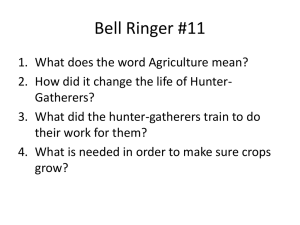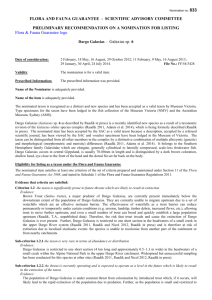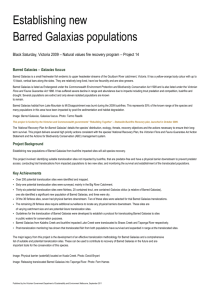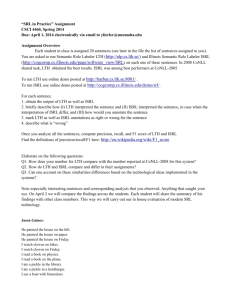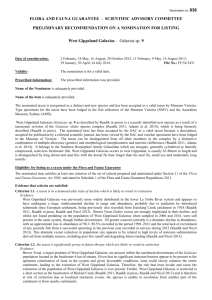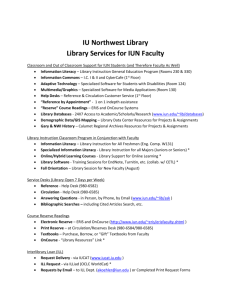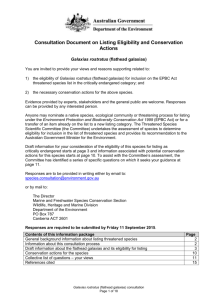Flow regimes - Department of Environment, Land, Water and Planning
advertisement
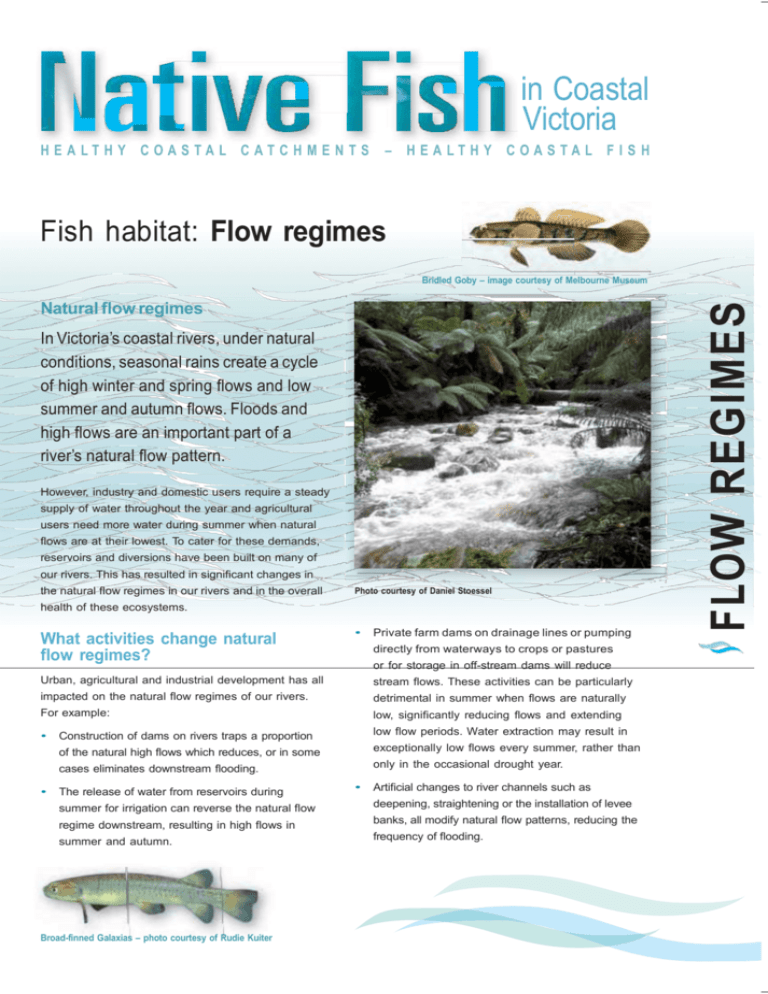
in Coastal Victoria HE A LTH Y COAS TAL C ATC H ME N TS – H EA LTH Y COAS TAL F I S H Fish habitat: Flow regimes Natural flow regimes In Victoria’s coastal rivers, under natural conditions, seasonal rains create a cycle of high winter and spring flows and low summer and autumn flows. Floods and high flows are an important part of a river’s natural flow pattern. However, industry and domestic users require a steady supply of water throughout the year and agricultural users need more water during summer when natural flows are at their lowest. To cater for these demands, reservoirs and diversions have been built on many of our rivers. This has resulted in significant changes in the natural flow regimes in our rivers and in the overall Photo courtesy of Daniel Stoessel health of these ecosystems. What activities change natural flow regimes? • Private farm dams on drainage lines or pumping directly from waterways to crops or pastures or for storage in off-stream dams will reduce Urban, agricultural and industrial development has all stream flows. These activities can be particularly impacted on the natural flow regimes of our rivers. detrimental in summer when flows are naturally For example: low, significantly reducing flows and extending • Construction of dams on rivers traps a proportion low flow periods. Water extraction may result in of the natural high flows which reduces, or in some exceptionally low flows every summer, rather than cases eliminates downstream flooding. only in the occasional drought year. • The release of water from reservoirs during • Artificial changes to river channels such as summer for irrigation can reverse the natural flow deepening, straightening or the installation of levee regime downstream, resulting in high flows in banks, all modify natural flow patterns, reducing the summer and autumn. frequency of flooding. Broad-finned Galaxias – photo courtesy of Rudie Kuiter FLOW REGIMES Bridled Goby – image courtesy of Melbourne Museum HE A LTH Y COAS TAL C ATC H ME N TS – H EA LTH Y COAS TAL F I S H How do changed flow patterns affect the health of the river? Threat – controlling flow Natural flood patterns are important to maintain river bathymetry. During floods sediment is moved and deposited downstream. Reduced flooding causes the build-up of sediments, which can fill natural pools and smother habitat. Without natural floods the river channel can decrease in size, reducing its capacity to contain the increases in flow during very wet years. Exceptionally low summer flows can cause the build-up This can cause the death of fish and other instream fauna and may impact on the health on aquatic flora. Loss of instream and riparian (streamside) vegetation will in turn Photo courtesy of Michelle Drew affect the riverbank’s ability to cope with erosion. Irrigation releases from dams can produce sustained high flows in summer, which can lead to the increased erosion of Some native fish species rely on seasonal high flows in riverbanks: high flows followed by a rapid reduction in water winter and spring to stimulate annual migration and/or to depth can cause water laden banks to collapse under their prepare for spawning. Without these cues, breeding can be own weight. The release of stored water can also cause severely interrupted. For example Tupong (Pseudaphritis urvillii) changes to the natural temperature regime in the river. need seasonal high flows to start migration and spawning. Reduced flooding can also cause the loss of wetland Female Tupong migrate downstream to their estuarine or habitats. Floodplain wetlands rely on seasonal river marine spawning grounds during high flows in late autumn and flooding as their primary water source. Without this early winter. Broad-finned Galaxias (Galaxias brevipinnis) require flooding, these wetlands may dry temporarily or in a rise in water level to stimulate spawning. The galaxias lays some cases, permanently. eggs along the edges of the streams where they require a In estuaries, a reduced stream flow can allow salt water to second high flow to cover the exposed eggs before they can travel further upstream or may result in an estuary closure. hatch. If the second rise in water is not received the eggs will Both changes will impact on the vegetation along the banks remain exposed and will not hatch. and the balance of estuarine and freshwater ecosystems. Australian fish have evolved to cope with drought conditions. In natural systems, extreme drought events may cause the How do changed flow patterns affect the health of native fish? loss of many individuals and in some cases the local extinction Rivers and streams contain a vast array of native fauna that events. However, when water extraction causes drought-like have evolved and adapted to the particular river conditions flow conditions to occur every year, there is little chance for and its natural flow patterns. Changes to these patterns can species to recolonise and they may be permanently lost. of that species. The migratory nature of many of our fish species enables many species to recolonise areas after severe affect the survival of the whole river ecosystem. What can you do to help? • Save water – reducing water demand from urban, agricultural and industrial users, means more water is available for environmental flow releases. Tupong – photo courtesy of Tarmo Raadik Published by the Victorian Government Department of Sustainability and Environment, Melbourne, December 2008 © The State of Victoria Department of Sustainability and Environment 2008 This publication is copyright. No part may be reproduced by any process except in accordance with the provisions of the Copyright Act 1968. Authorised by the Victorian Government, 8 Nicholson Street, East Melbourne. ISBN 978-1-74208-830-3 (Print) ISBN 978-1-74208-831-0 (PDF) For more information contact the DSE Customer Service Centre 136 186 or write to research@dse.vic.gov.au, Arthur Rylah Institute, Department of Sustainability and Environment, PO Box 137, Heidelberg 3084. This publication may be of assistance to you but the State of Victoria and its employees do not guarantee that the publication is without flaw of any kind or is wholly appropriate for your particular purposes and therefore disclaims all liability for any error, loss or other consequence which may arise from you relying on any information in this publication. www.dse.vic.gov.au/ari FLOW REGIMES of nutrients, chemicals or saline water in stagnant pools.

